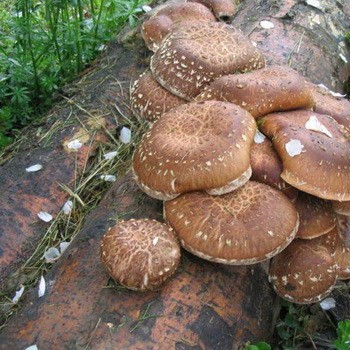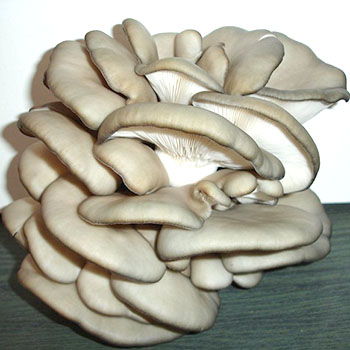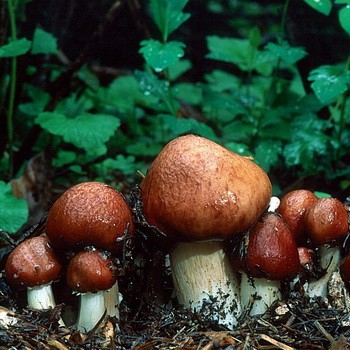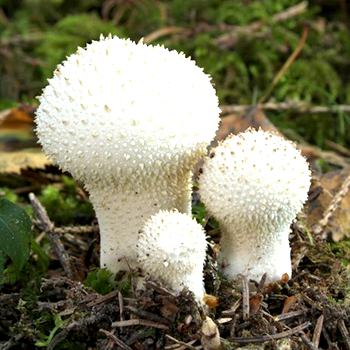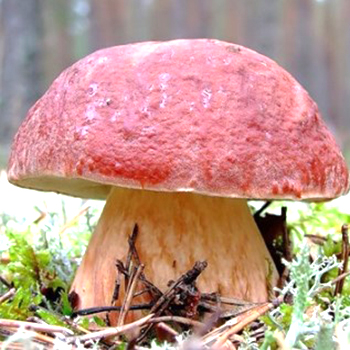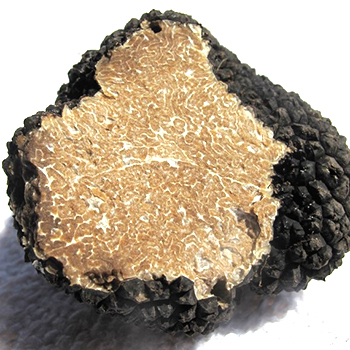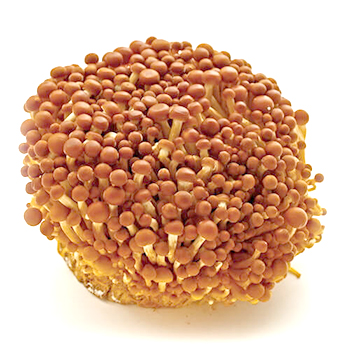Champignon cultivation in the basement and on an industrial scale
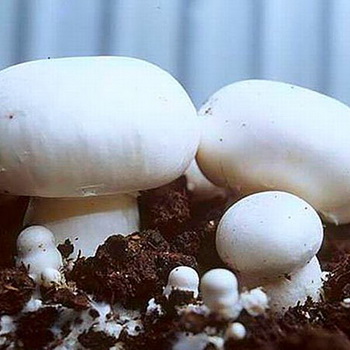
Content
- How to grow champignon mushrooms in the basement
- Technology for growing champignons on an industrial scale
- Conditions for growing champignon mushrooms
- Composting for champignons: pasteurization technology
- Growing champignon mushrooms on shelves (with video)
- Climatic equipment for growing champignon mushrooms
How to grow champignon mushrooms in the basement
Mushroom cultivation champignons (Agaricus bisporus) is possible exclusively using a special substrate called champignon compost. It is almost impossible to make it yourself in a small estate. Therefore, you need to buy compost and cover soil at a nearby champignon production or from specialized compost manufacturers.
Before growing mushrooms in the basement, you need to buy compost “in bulk”, seeded with mycelium, ready for incubation. You bring it to the estate and put it yourself in bags or on shelves. Then the mycelium develops compost in the cultivation room. After this, it is necessary to fill the integumentary soil, wait until it grows with mycelium and, finally, get the mushrooms.
Currently, manufacturers of champignon compost offer it for sale in the form of compressed briquettes, already seeded with mycelium. Briquettes measuring 20 x 40 x 60 cm are wrapped in plastic wrap. They can be transported even by car. You can also buy cover soil from the compost manufacturer (at the rate of 10 liters per briquette with compost).

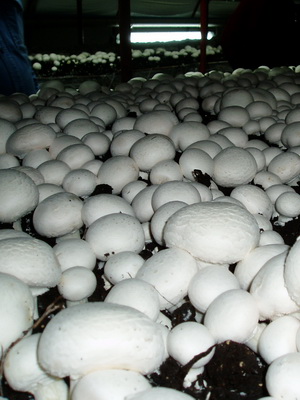
Before you begin to grow champignon mushrooms in the basement, you need to measure the temperature in the brought compost briquettes. On the floor or on the shelf in the cellar, put the briquettes close to each other in the form of a bed 1.4 m wide. The temperature of all briquettes will equalize during the day. Then cut off the top film. You will get a bed with a height of 20 cm. Cover the surface of the bed of blocks with kraft paper or newspapers. Moisten the paper with any sprayer at the rate of 0.2 l of water per 1 m2 of beds, preventing water from seeping into the compost. The incubation duration is from 14 to 25 days. After the mycelium reaches the compost surface (the appearance of individual spots of mycelium hyphae), it is time to apply the integumentary soil. The soil is applied with a layer of 4 cm (40 l per 1 m2 of compost surface). It must be leveled and poured with water at the rate of 2 liters per 1 m2 of ridges, spraying is necessary in the next three days. On the fourth day, the mycelium usually grows into the cover soil to a depth of 0.5 cm. At this time, begin regular irrigation twice a day with 1 liter of water per 1 m2 of cover soil. 12 days after applying the integumentary soil, the mycelium penetrates the entire integumentary layer and reaches its surface.
The period of fruit formation begins. At this time, watering is stopped.
Air temperature should be + 14 ... + 17 ° С, relative air humidity - 85-95%. Under these conditions for growing champignons in the basement on the 15-20th day, counting from the day the cover soil was applied, white “stars” from the mycelium should appear on its surface. A few days later - the primordia of mushrooms in the form of white peas. According to the technology of growing champignons in the basement, watering is resumed the next day after the appearance of the pea primordia “by mushrooms” at the rate of up to 1 l / m2.
Gathering mushrooms, they should be pulled out of the ground, cut off the tip of the legs and carefully put in boxes.
Now you know how to grow champignons yourself, it remains to equip the basement, and you can go for the substrate.
Watch a video of growing champignons in a specially equipped basement to better understand the process technology:
Technology for growing champignons on an industrial scale
Champignon cultivation on an industrial scale begins with the fermentation of champignon compost. As the basis of compost for these mushrooms, wheat straw mixed with farm animal manure is used. Attempts to replace straw with other ingredients have been unsuccessful. Manure can be horse, sheep, cow or pork, but more stable results are obtained using dried broiler chicken droppings. For the necessary heating of the compost during its fermentation, the mass of the shoulder must be at least 7 tons.
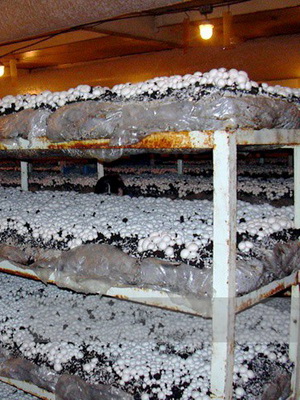
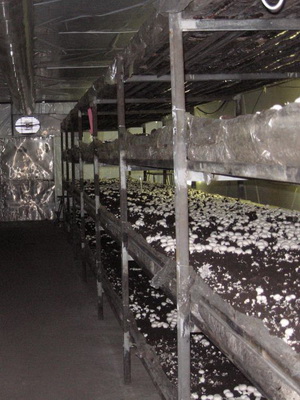
The classic technology for growing champignons on an industrial scale is based on the fermentation of compost mixture in long shoulders 1.8 m high and 2.0 m wide.
During the preliminary soaking of straw, stacked in piles, the bulk of the irrigation water is drained into the sewage system. For its reuse (recycled water), a tank equipped with a pump is needed. Depending on the air temperature in the workshop and on the nitrogen content in the recycled water, the process of soaking the straw takes up to 8 days.
According to the technology for the industrial cultivation of champignons, for each ton of dry straw, soaking in piles requires a concrete area of 35 m2 and a platform of 30 m2 to form a pile. Three tons of “green” compost can be made from each ton of straw. For each 3 tons of ready-made compost, the composition of the ingredients for laying in the pile and the water flow rate are: wheat straw - 1000 kg, dry litter from cages with chicken content - 800 kg, gypsum - 60 kg, water 10000 l. Of this amount, a shoulder with a mass of 7 tons will be obtained.
The collars are formed using wheel technology or manually, laying layer-by-layer soaked straw, dry droppings and gypsum. The microbiological process of transformation of straw in the pile (fermentation) occurs at a temperature inside the pile + 48 ... + 53 ° C. The optimum compost moisture during fermentation is 68-75% at pH = 8-8.3 and in the presence of a sufficient amount of oxygen. Until the 20th day of fermentation, the pile is poured daily with circulating water and interrupted three times to aerate the air and mix the ingredients. The compost fermentation can be considered complete when the content of ammonium ions NH4 + in it drops below 0.6%.
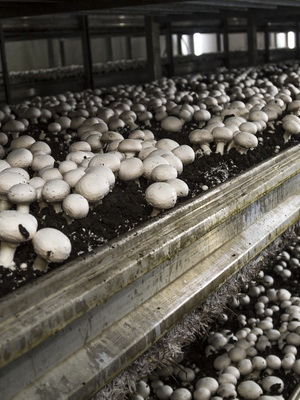
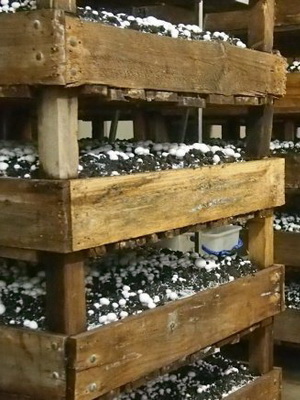
Observing the correct technology for growing champignons in an industrial way, high quality compost is obtained only when using recycled water. Water from irrigation of straw and piles is collected in a huge underground pit, in which a drainage pump is installed, which supplies water for irrigation. Water in the pit must be aerated around the clock. Enrichment with oxygen prevents the proliferation of anaerobic bacteria and contributes to the development of aerobic bacteria useful for compost. It is futile to try to aerate the circulating water by spraying it in the air. Only a powerful jet that strikes the surface of the water will provide high-quality aeration of the circulating water. A separate drainage pump will help here, creating a pressure of 6 atm.
Conditions for growing champignon mushrooms
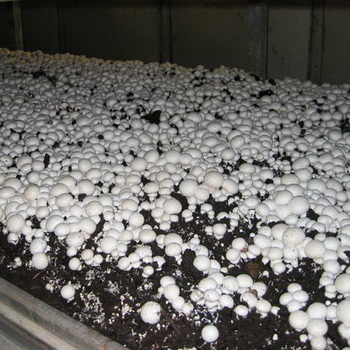 Premises for growing champignon mushrooms on an industrial scale are special facilities: bunkers and tunnels.
Premises for growing champignon mushrooms on an industrial scale are special facilities: bunkers and tunnels.
A more efficient way to make green compost is to heat it and ferment it in silos. The bunker is a room with an aerated floor, fenced with three walls. There is no fourth wall, which allows loading and unloading of compost using wheeled vehicles. The necessary conditions for growing champignons are supported by a high-pressure fan, which pumps air under a pressure of 5000 Pa into the system of pipes equipped with nozzles under the hopper floor, and he, in turn, is forced through the nozzle in the floor through the layer of compost and aerates it. The diameter of the nozzles is 8 mm, the distance between the nozzles is 40 cm. For 60 tons of compost stacked in a heap 4 meters high, you need a hopper with an area of 40 m2. The compost in the hopper does not have to be laid flat. There may even be a part of the floor that is not filled with compost, but the compost will still be aerated because in the underground of even an empty hopper, the fan holds a pressure of at least 2500 Pa. To create optimal conditions for growing champignon mushrooms, better aeration of heaps with straw and compost outside the hopper, aerated floors with nozzles are used. Under the necessary sections of the floor of the composting workshop, an underground air space is built in which a high-pressure fan pumps air.
The compost processing process in the hopper begins by soaking the straw. Then compost (a mixture of straw, litter and gypsum) on the aerated floor is watered with circulating water and stirred for 2 days. Then the compost is loaded into the hopper, where it heats up to +80 ° C in two days. Unload, mix and reload into the hopper for 3 days to warm up. Unload on the aerated floor. Now the “green” compost is ready, and it can be transported into the tunnel for pasteurization and conditioning.
Tunnel - This is a narrow and long room for growing champignons, where champignon compost is prepared. In this process, aerobic microorganisms play an important role. The tunnel is designed so that thermophilic aerobic bacteria and actinomycetes develop in the “green” compost loaded there. To do this, the floor of the tunnel is perforated, and air is forced into the underground space, which is passed through the compost, creating conditions for aerobic heat-loving bacteria and actinomycetes, which turn the “green” compost made in collars or in bunkers into “brown” champignon mycelium ready for inoculation compost. Out of every 3-3.2 tons of “green” compost, 2 tons of “brown” are obtained.
Unlike the hopper, the tunnel should be loaded with compost in an even layer so that there are no open compost slots in the floor through which air will exit the underfloor, causing a drop in pressure there.
Composting for champignons: pasteurization technology
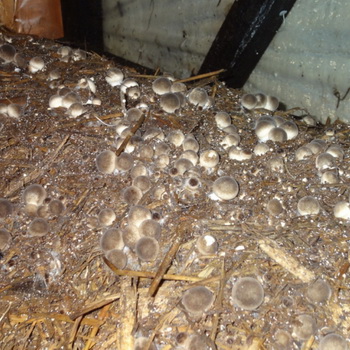 To prepare compost for mushrooms, pasteurization and conditioning technology is used. The air-permeable perforated floor of the tunnel is selected from reinforced concrete or oak beams perpendicular to the long side of the tunnel with intervals between them of 3-5 cm. A tunnel of 3 m width is considered standard. The cross section of oak beams from 150 x 150 mm to 200 x 200 mm, reinforced concrete - is determined their durability. The sectional shape is either square or trapezoidal with the wide base up. In the latter case, the probability of clogging of the cracks is less. The perforated floor is laid so that its surface is at ground level or at the floor level of the substrate workshop.
To prepare compost for mushrooms, pasteurization and conditioning technology is used. The air-permeable perforated floor of the tunnel is selected from reinforced concrete or oak beams perpendicular to the long side of the tunnel with intervals between them of 3-5 cm. A tunnel of 3 m width is considered standard. The cross section of oak beams from 150 x 150 mm to 200 x 200 mm, reinforced concrete - is determined their durability. The sectional shape is either square or trapezoidal with the wide base up. In the latter case, the probability of clogging of the cracks is less. The perforated floor is laid so that its surface is at ground level or at the floor level of the substrate workshop.
According to the manufacturing technology of compost for champignons, before loading the substrate on the perforated floor, a strong litter polymer net is laid, which is fixed on the floor. A sliding grid is spread over the litter to draw compost on it with the help of an electric winch.Passing tunnels are loaded from a conveyor belt or bucket tractor, and unloaded from the other side using a sliding grid. At a distance of 0.5 m from the gate, a panel wall is made of horizontal bars. The wall allows you to load the tunnel to the desired level with the gate open and separates the compost from the gate with an insulating air space. The foundation of the tunnel forms an underground airspace into which air is pumped at a pressure of 1500 Pa.
The loading schedule of the compost fermented in collars or in silos may be as follows.
On the 1st day - loading the tunnel until 12 noon. Equalization of temperature in the mass of the substrate using recirculation air with a small supply of fresh air and heating for 12 hours to 58 ° C. Pasteurization of compost for champignons lasts 10 hours, this is necessary to kill insects. Then, to condition the compost, its temperature is reduced to + 48 ... + 50 ° С by increasing the flow of fresh 88 air. Air conditioning at this temperature under purging conditions through an air compost (10% fresh air, 90% recirculation air) lasts 5 days.
On the 6th day, the compost is cooled to grow mushrooms for 8-12 hours to 8 hours in the morning by increasing the amount of fresh air. The content of ammonium ions in the compost at the exit of the tunnel should be less than 0.1%. The “brown” compost has almost no smell of ammonia.
Now in Russia there are Italian automatic compost presses. They immediately form mycelium-seeded compost in the form of compressed briquettes and pack them in a plastic film. The size of a standard briquette is 20 x 40 x 60 cm. The surface of the film into which the block is packed is not perforated, except for two large holes at the ends of the block, which almost do not violate the strength of the block, but provide oxygen to the mycelium in the block during transportation.
Growing champignon mushrooms on shelves (with video)
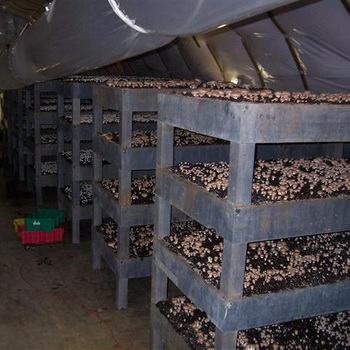 It is possible to cultivate champignon on multi-tiered racks. In a standard cultivation chamber with an area of 200 m2, size 11 x 18 m with a ceiling height of 3.8 m, designed to accommodate 40 tons of compost, 4 five-tier shelves with a width of 1.4 m and a length of 15 m are installed. The rack for growing champignons is a shelf with shelves fenced with sides so that compost and integumentary soil are not poured. The first tier of the whatnot is at an altitude of 0.25 m from the floor, the next tiers are 0.6 m from each other.
It is possible to cultivate champignon on multi-tiered racks. In a standard cultivation chamber with an area of 200 m2, size 11 x 18 m with a ceiling height of 3.8 m, designed to accommodate 40 tons of compost, 4 five-tier shelves with a width of 1.4 m and a length of 15 m are installed. The rack for growing champignons is a shelf with shelves fenced with sides so that compost and integumentary soil are not poured. The first tier of the whatnot is at an altitude of 0.25 m from the floor, the next tiers are 0.6 m from each other.
The width of the aisles between the shelves for mushrooms is 110 cm, between the shelves and walls - 100 cm.
When compost is placed in the form of beds, poured onto shelves, on 1 m2 of shelves, it is possible to lay 100 kg of finished compost. Compost thickness with proper compaction is 20 cm. With a bed width of 1.4 m, 4 x five-tier shelves 15 m long will fit 1.4 x 15 x 5 x 4 x 0.1 = 42 tons of compost.
Compost is placed on racks for champignon mushrooms, then leveled and compacted. Grain mycelium is poured evenly on the surface of the compost, then it is sealed to a depth of 1 cm. The seeding rate of grain mycelium is 0.4-0.5% of the weight of the finished compost.
The compost surface is leveled and covered with paper. Humidify the paper by spraying with water (up to 0.2 l per 1 m2 of beds), preventing water from seeping into the compost. Using this method of growing champignons, the incubation of mycelium at a compost temperature of + 20 ... + 26 ° C ends after 14 days. After that, cover soil is applied and it is overgrown with it for 10 days. Watering on cover soil up to 2 liters per 1 m2 of ridge.
After the mycelium has mastered the integumentary soil, the formation of mushrooms begins. The temperature in the cultivation chamber is regulated in the range from +14 to +17 ° C with a relative humidity of 85-95%. For constant removal of carbon dioxide during the setting and fruiting of mushrooms, ventilation with fresh air in the amount of at least 250 m3 / h per each ton of substrate is required. The ventilation system must supply 10,000 m3 / h to the chamber.
According to the correct technology for growing champignons, the movement of fresh air over shelves with mushrooms should be ensured in the chamber.
To create an air flow over the mushrooms in each odd passage, special equipment for growing champignons is placed - an air duct with nozzles pointing down. In the simplest case, the duct is a 15 m long blown polyethylene sleeve suspended on wire rings in the middle of the aisle so that the nozzles are 40 cm above the compost surface on the upper shelf and the air flow from the nozzles is directed vertically downward.
When ventilation with fresh air, the carbon dioxide content in the upper layer of integumentary soil is much less than in depth. This leads to the formation on the surface of the integumentary soil of the rudiments of fruiting bodies. On the 15-20th day, counting from the day of application of the integumentary soil, white stars from the mycelium appear on the surface of the integumentary soil, and after a few days - the primordia of mushrooms in the form of white peas. Watering up to 1 l / m2 should begin the next day after the appearance of the primordia peas.
The video “Growing champignon mushrooms on multi-tiered racks” shows how this process occurs:
Climatic equipment for growing champignon mushrooms
A room for growing champignons must be equipped with a ventilation system.
Fresh air is drawn through a filter, passed through a heater and cooler, sucked in by a central fan and humidified by a water vapor nozzle. Condensate is removed by a drop eliminator. This part of the climatic equipment for growing champignons is a central air conditioner. Its functional purpose is pre-conditioning of air with a relative humidity of 80-90% and with a temperature of 10-13 ° C in the summer and 15 ° C in the winter. After preparation, air enters the central duct, from which it is taken in by chamber fans, called in this case “closers”. From the central duct of the equipment for champignon mushrooms, air is drawn through the wall of the cultivation chamber into a mixing box with an air adjustment valve, passes through a cooler and heater, and is pumped by a fan into the chamber duct. Directly in front of the chamber duct are the steam nozzle and droplet eliminator.
In mushroom production, centrifugal fans with backward curved blades are recommended. The capacity of the chamber fan-closer in equipment for growing champignon mushrooms in a chamber for 40 tons of compost should be 10,000 m3 / h. Such a fan provides a supply of fresh air-conditioned air of 250m3 / hour for each ton of compost. The operating pressure of the fan must be at least 500 Pa.
The volume of air distributed by the nozzles in one chamber is 10,000 m3 / h.
The fresh air adjustment valve is capable of replacing, if necessary, fresh air with the chamber air (recirculation air) within the range of adjustment from 0% of fresh air in the chamber duct to 100%.
Abroad, plastic nozzles in climatic equipment for champignons are made with an inner diameter of 5 cm. You can make nozzles from plastic cups for water that hold well in polyethylene if the holes are made slightly smaller than the diameter of the wide part of the cup. Long glasses for beer with a volume of 0.5 l with a bottom diameter of 6 cm have proven themselves best. The bottoms of the glasses are cut so that the inside of the nozzle is smooth. The holes in the polyethylene sleeve are cut with scissors so that the nozzles are turned down after straightening the inflated duct, in the middle of the middle passage in the chamber. When the height of the shelves is 3 m, the velocity of air flow from nozzles with a diameter of 6 cm should be 8 m / s. A chamber fan, developing a pressure of 400-500 Pa, will provide such a speed. With a nozzle diameter of 6.0 cm and an air outflow rate of 8 m / s from the nozzles, the air flow through one nozzle will be 81 m3 / h.The total number of nozzles in the chamber 10000: 81 = 120 pcs. The speed of air in the distribution duct of the chamber should not be higher than half the speed of the outflow of air from the nozzles.
